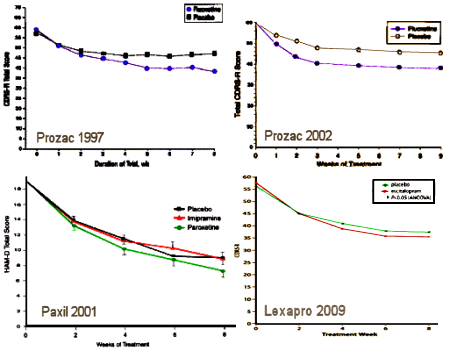On February 29th, I said I smell a campaign… I take no joy in having been right about that. I thought it was a Lilly [Cymbalta] and Pfizer [Pristiq] show, but I see Forest Laboratories [Viibryd] has joined in the mix [sponsoring the Emslie/Gibbons Medscape C.M.E.]. Looking over the list of authors in that Journal of Child and Adolescent Psychopharmacology free issue, a lot of the authors are recycled from last time around [Karen Dineen Wagner, Benedetto Vitiello, Martin Keller, Graham J. Emslie, John S. March].
As described in a recent article by the NIMH Director, Tom Insel, on transforming psychiatry as a clinical discipline, the age of symptomatic diagnosis and current generation treatments is passing; the age of interventions that emerge from the revolution in translational developmental neuroscience has begun. The twin NIMH Council workgroup reports on translational developmental neuroscience and interventions research, respectively, which shift the National Institute of Mental Health away from current generation treatments and toward early phase clinical pharmacology, presage the development of just these kind of preemptive treatments. Because these newer interventions will emerge from an improved understand of the fundamental biology of the illnesses, they should be more effective in patients who are ill and, excitingly, will eventually become preventive if not preemptive, e.g. they will be delivered to very young children who are at risk but not yet showing early signs of mental illness. As a result, pediatric psychiatry will increasingly become the front end [the most important end] of a lifespan developmental model for mental illnesses. More than a little humility is required as this vision unfolds over the next many years. For a while, studies in adults will still lead studies in youth: developing interventions for mentally ill youth will emerge once the fundamental biology catches up such that science drives innovation and innovation drives application in the form of interventions. As part of this process, biomarkers on the road to stratified and ultimately personalized medicine will be a key development – finally, the age of molecular diagnosis and the dawn of the age of companion diagnostics to optimize treatment for psychiatric illness. For the field of pediatric psychopharmacology to thrive it will be important to embrace and actively participate in this revolution, including addressing its ethical implications, so that mentally ill youth are viewed as a key target population and, consequently, truly preemptive, preventive and curative interventions will be developed for children by first intent.
But I don’t think all of us agree that the point is for the "field of pediatric psychopharmacology to thrive." In fact, given it’s track record, I’m thinking this groundhog might just take another look and go back in the hole. Here’s Graham Emslie’s track record:

In January, I sat through a trial watching slide after slide of Call Notes written by drug reps about their efforts detailing Risperdal to Child Psychiatrists off-label and giving them articles that disproved reports about obesity, diabetes, etc. [claims that were actually true]. I can see another generation of drug reps carrying reprints of Dr. Gibbons recent articles extolling the virtues of the SSRIs and SRNIs in child and adolescent depression. And maybe in the future, one of you will be observing the trial of a suit brought by parents of kids who suicided on Viibryd, or Cymbalta, or Pristiq, watching similar slides – but I hope not.
Yesterday was a busy day. My wife had an outpatient surgical procedure at 0-dark-thirty AM. It was a miracle of modern medicine itself – the insertion of an artificial joint into her big toe. Sitting in the waiting area, I pondered the wonders of modern medicine that can replace a painfully frozen toe with titanium and silicon. Afterwards, the surgeon spent 15 minutes proudly talking to me about the recent advancements in science that lead to the new toe-joint technology. Medicine is like that. Doctors identify with the advances as if they, themselves, made the discoveries. I felt really good about the symbiotic relationship between the foot surgeons and their toe joint developers. Of course I wondered if he had any financial connection with the toe-joint company, but I didn’t ask. I guess I’m not much different that anybody else in that regard. I’d rather hold onto my Marcus Welby fantasies that the world of Medicine is unafflicted by commercial forces. And it wasn’t lost on me that there were a couple of direct-to-consumer advertisements [fibromyalgia and depression] on the inevitable waiting room television, but not a one for improved big toe-joint devices for Hallux Rigidus.
The shills at the top might very well know exactly what they’re doing, and what they’re doing is making a lot of mental health professionals true believers.
During my recent and only commitment at the age of 50, I commented at a group meeting on the fact that there were three copies on one wall of a NAMI poster claiming that great people in history suffered from mental illness. The list included Abraham Lincoln and diagnosed him with Depression.
A social worker on that staff told my friend of thirteen years that he should go to the NAMI website to get insight into my mental illness. NAMI was being treated as if it were an authority on mental illness and not a company run by drug company lobbyists.
This all is really a runaway freight train…Pharma & Institutionalized Psychiatry has ownership of the railroad, will never relinquish power, or pull the stop lever until they have every man, women, & child under their unyielding chemical control.
It is fast becoming unpleasantly obvious that the only solution may soon come down to manually pulling up the tracks, and then going about blowing up all the stations. 🙁